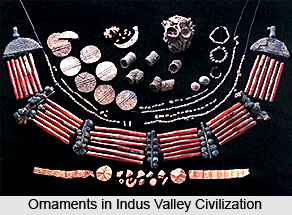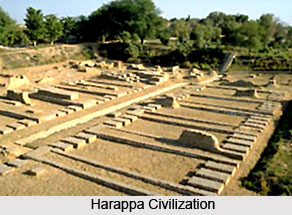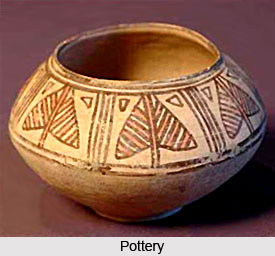 India`s past was revealed by the recent discoveries made in the Punjab and Sindh which was watered by the Indus, hence the name given to these cultures as the Indus Valley civilisation. Mohenjo-Daro seems to have been a smaller city than Harappa. It may have been larger for its outskirts which are buried beneath the silt deposited by the river Indus.
India`s past was revealed by the recent discoveries made in the Punjab and Sindh which was watered by the Indus, hence the name given to these cultures as the Indus Valley civilisation. Mohenjo-Daro seems to have been a smaller city than Harappa. It may have been larger for its outskirts which are buried beneath the silt deposited by the river Indus.
Architecture and Masonry in Indus Valley Civilization
The cities appear to have been laid out in accordance with some pre-arranged scheme according to their foundations. For example, in Mohenjo-Daro the streets run in straight lines and are crossed at right angles. This suggests planning and existence of some authority to control the development of the city. Town-planning was also accompanied by strict enforcement of building regulations as great care was taken to prevent any structure from encroaching upon the streets. Masonry was excellent and houses were carefully built. Sanitation and hygiene was paid due importance. Streets were wide. The buildings made of burnt bricks and it was devoid of decoration. The windows hardly existed and the entrances were placed in narrow by-ways. These cities were divided into wards for protection.
 Dress and Ornaments in Indus Valley Civilization
Dress and Ornaments in Indus Valley Civilization
The dress on the clay figures can be considered as the normal attire of the female population. These figures are bare to the waist and wear only a scanty skirt. The skirt is held by a girdle made either of beads or of bands of woven material. There are also head-dresses probably made of stiffened cotton cloth. The male figures are generally nude. There is a probability that robs with or without embroidery was worn over the left shoulder and under the right arm. No footwear as such is to be found. It seems that people were fond of jewellery and hair-dressing. Various types of jewellery have been unearthed made both of stones and of gold and silver. Men had varied styles of hair-dressing, for instance, one wears his hair parted in the middle and the short locks at the back of the head are kept tidy by a woven fillet. Curling hair is also found. Beards were trimmed in various fashions. The metal ornaments were made of gold, silver, copper and bronze. Stones used were like lapis lazuli, turquoise. The ornaments are girdles, necklaces, bracelets, pectorals, beads, cones, ear-rings, nose-rings, finger-rings, anklets, bangles,
 Language in Indus Valley Civilization
Language in Indus Valley Civilization
The script on the seals is pictographic bearing a close resemblance to the Proro-Elamitc script in Babylonia. Some writers claim that the language see in the animals on the Harappa seals symbols is a kind of writing used in the Tantric books. There are many signs found on the script, accompanied by inscriptions on seals, pottery and bangles. The direction of the writing has been from right to left.
Amusements in Indus Valley Civilization
Toys were used by children for amusement. Men were indulged in gambling. This was the board game in which men were moved on the boards and dice was used. Games were also played with pebbles. Dancing was popular. Drum, tambourine, castanets are the musical instruments that have been found.
Arts and Crafts in Indus Valley Civilization
The people of the Indus Valley had a large variety of pottery, both decorated and plain. All the ornamented wares are coated with opaque, red slip, upon which various designs and motifs are painted with a thick black pigment. Figures of trees, animals and birds also occur. Pottery was used as jars for storage purposes of various kinds. It was used for drinking and keeping ornaments. Use of glaze has been found. Objects of extraordinary fine workmanship were also visible. Vases were made of ivory has been also found. Gold needles have been discovered; probably they were used in embroidery.
Thus it can be said that the Indus Valley people were more urban and mercantile. Planned cities were a major feature of their culture.



















